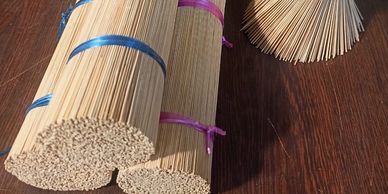Signed in as:
filler@godaddy.com
Signed in as:
filler@godaddy.com

See our products here:- https://www.indiamart.com/gcube-sticks/

Bamboo is a perennial evergreen that is part of the grass family; it is very tall grass with woody stems. With well over 1700 species worldwide and many still being discovered, bamboo grows everywhere except for places with extremely cold climates. Unlike trees, bamboos do not have any secondary growth. Rather, as the rhizome system develops and matures, new and larger shoots emerge annually until the maximum size of the species has been reached. The life of a culm varies from species to species. Usually, a culm is fully mature after 3 or 4 years. As mature culms grow older, they deteriorate and eventually die and rot. The life of the bamboo plant is however sustained by the new shoots and culms. A large no of rural indigenous people are depending on bamboo for their livelihood. However some species has more economic value due to the various and multiple industrial usage.
From time immemorial, bamboo has been used by almost all the communities for various traditional and domestic purposes. With passage of time, advancement of civilization and gradually the globalization, bamboo has emerged as an important material for commercial use. Bamboo consumed for commercial processing requires meeting the suitability in terms of maturity, weight, mechanical properties, biological properties, cost etc. However the present bamboo cultivation supply chain is yet to be developed into an organized and revenue generated sector model. Bamboo being an annual yielding crop with multipurpose utility has proven potential for contributing to poverty reduction, environmental protection and achievement of United Nations Sustainable Development Goals – SDG1, SDG7, SDG 11, SDG 12, SDG 13, SDG 15, and SDG 17

· Renewable Resource: Depending on the species, bamboo can be harvested in one to five years. Hardwoods like oak take 30-40 years to mature before they can be harvested. Almost 1 million acres of forests are lost each week worldwide to deforestation. Bamboo's versatility as a substitute for hardwoods offers a chance to drastically reduce that figure and protect the forests that we have left.
· Absorbs Greenhouse Gases: Bamboo absorbs carbon dioxide and releases 35% more oxygen into the atmosphere than an equivalent stand of hardwood trees.
· Amazing Growth Rate: Some species of bamboo grow more than three feet each day. No plant on the planet features such a faster growth rate. When it is harvested, it will grow a new shoot from its extensive root system with no need for additional planting or cultivation.
· Very little waste: After harvesting, virtually every part of the plant is used to make a wide variety of products. From soil-enriching mulch to beautiful furniture to chopsticks, every part of the plant can be utilized.
· Versatility: Bamboo can replace the use of wood for nearly every application. Paper, flooring, furniture, charcoal, building materials and much more can be made from bamboo. Bamboo fibres are far stronger than wood fibres and much less likely to warp from changing atmospheric conditions.
· No Fertilizer, Pesticides, Herbicides Needed: Unlike most cash crops, bamboo does not require any agricultural chemicals to thrive. Unlike cotton, which is one of the most intensely sprayed crops in the world and rapidly depletes the nutrients in the soil, bamboo sequesters nitrogen and its cultivation does not add chemicals to the environment.
· Soil Protection: Once hardwood forests are clear-cut and the stumps are burned to provide fertilizer and space for growing crops, erosion inevitably occurs as the topsoil and nutrients are washed away by rainfall. The eroded soil then clogs rivers and streams and affects the lives of people and animals living downstream. Bamboo roots remain in place after harvesting where they prevent erosion and help retain nutrients for the next crop.
Bamboo Grows in a Variety of Conditions: Bamboo can grow in arid regions where droughts cause other crops to fail and since the roots are left in place after harvesting, it helps to preserve vital moisture in the soil. From low wetlands to higher elevations in the mountains, bamboo thrives in a wide range of climates.
Copyright © 2025 G Cube - All Rights Reserved.
We use cookies to analyze website traffic and optimize your website experience. By accepting our use of cookies, your data will be aggregated with all other user data.